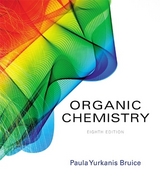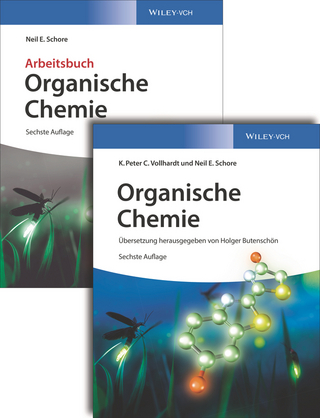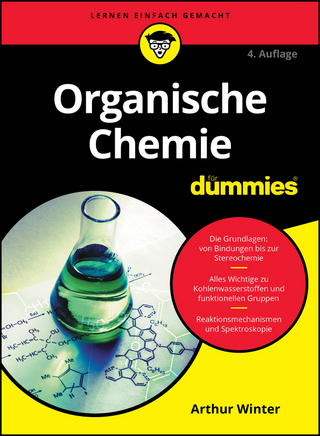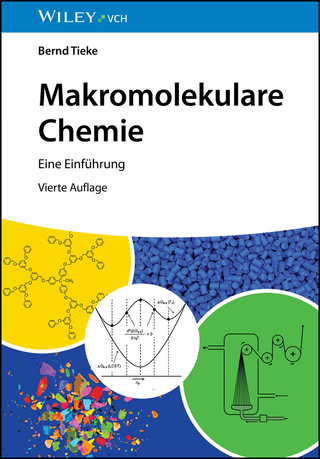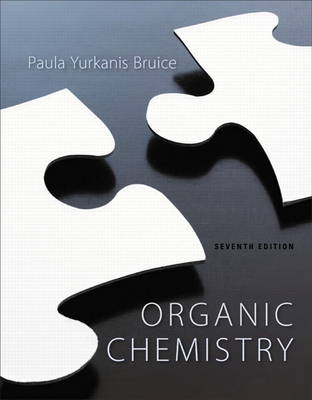
Organic Chemistry
Pearson (Verlag)
978-0-321-80322-1 (ISBN)
- Titel erscheint in neuer Auflage
- Artikel merken
In consideration of today’s classroom dynamics and the changes coming to the 2015 MCAT, this revision offers a completely new design with enhanced art throughout, reorganization of materials to reinforce fundamental skills and facilitate more efficient studying.
Paula Yurkanis Bruice was raised primarily in Massachusetts. After graduating from the Girls’ Latin School in Boston, she earned an A.B. from Mount Holyoke College and a Ph.D. in chemistry from the University of Virginia. She then received an NIH postdoctoral fellowship for study in the Department of Biochemistry at the University of Virginia Medical School and held a postdoctoral appointment in the Department of Pharmacology at Yale Medical School. Paula has been a member of the faculty at the University of California, Santa Barbara since 1972, where she has received the Associated Students Teacher of the Year Award, the Academic Senate Distinguished Teaching Award, two Mortar Board Professor of the Year Awards, and the UCSB Alumni Association Teaching Award. Her research interests center on the mechanism and catalysis of organic reactions, particularly those of biological significance. Paula has a daughter and a son who are physicians and a son who is a lawyer. Her main hobbies are reading mystery and suspense novels and enjoying her pets (two dogs, two cats, and a parrot).
Part 1 An Introduction to the Study of Organic Chemistry
1 Remembering General Chemistry: Electronic Structure and Bonding
1.1 The Structure of an Atom
1.2 How the Electrons in an Atom Are Distributed
1.3 Ionic and Covalent Bonds
1.4 How the Structure of a Compound Is Represented
1.5 Atomic Orbitals
1.6 An Introduction to Molecular Orbital Theory
1.7 How Single Bonds Are Formed in Organic Compounds
1.8 How a Double Bond Is Formed: The Bonds in Ethene
1.9 How a Triple Bond Is Formed: The Bonds in Ethyne
1.10 The Bonds in the Methyl Cation, the Methyl Radical, and the Methyl Anion
1.11 The Bonds in Ammonia and In the Ammonium Ion
1.12 The Bonds in Water
1.13 The Bond in a Hydrogen Halide
1.14 Hybridization and Molecular Geometry
1.15 Summary: Hybridization, Bond Lengths, Bond Strengths, and Bond Angles
1.16 The Dipole Moments of Molecules
2 Acids and Bases: Central to Understanding Organic Chemistry
2.1 An Introduction to Acids and Bases
2.2 pka and pH
2.3 Organic Acids and Bases
2.4 How to Predict the Outcome of an Acid—Base Reaction
2.5 How to Determine the Position of Equilibrium
2.6 How the Structure of an Acid affects its pKa Value
2.7 How Substituent’s affect the Strength of an Acid
2.8 An Introduction to Delocalized Electrons
2.9 A Summary of the Factors That Determine Acid Strength
2.10 How pH affects the Structure of an Organic Compound
2.11 Buffer Solutions
2.12 Lewis Acids and Bases
Tutorial: Acids and Bases
3 An Introduction to Organic Compounds: Nomenclature, Physical Properties, and Representation of Structure
3.1 How Alkyl Substituents Are Named
3.2 The Nomenclature of Alkanes
3.3 The Nomenclature of Cycloalkanes • Skeletal Structures
3.4 The Nomenclature of Alkyl Halides
3.5 The Nomenclature of Ethers
3.6 The Nomenclature of Alcohols
3.7 The Nomenclature of Amines
3.8 The Structures of Alkyl Halides, Alcohols, Ethers, and Amines
3.9 The Physical Properties of Alkanes, Alkyl Halides, Alcohols, Ethers, and Amines
3.10 Rotation Occurs about Carbon—Carbon single Bonds
3.11 Some Cycloalkanes Have Angle Strain
3.12 The Conformers of Cyclohexane
3.13 Conformers of Monosubstituted Cyclohexanes
3.14 Conformers of Disubstituted Cyclohexanes
3.15 Fused Cyclohexane Rings
Part Two Electrophilic Addition Reactions, Stereochemistry, and Electron Delocalization
Tutorial: Using Molecular Models
4 Isomers: The Arrangement of Atoms in Space
4.1 Cis—Trans Isomers Result from Restricted Rotation
4.2 A Chiral Object Has a Nonsuperimposable Mirror Image
4.3 An Asymmetric Center is a Cause of Chirality in a Molecule
4.4 Isomers with One Asymmetric Center
4.5 Asymmetric Centers and Stereocenters
4.6 How to Draw Enantiomers
4.7 Naming Enantiomers by the R, S System
4.8 Chiral Compounds Are Optically Active
4.9 How Specific Rotation Is Measured
4.10 Enantiomeric Excess
4.11 Compounds with More than One Asymmetric Center
4.12 Stereoisomers of Cyclic Compounds
4.13 Meso Compounds Have Asymmetric Centers but Are Optically Inactive
4.14 How to Name Isomers with More than One Asymmetric Center
4.15 How Enantiomers Can be Separated
4.16 Nitrogen and Phosphorus Atoms Can Be Asymmetric Centers
Tutorial: Interconverting Structural Representations
5 Alkenes: Structure, Nomenclature, and an Introduction to Reactivity • Thermodynamics and Kinetics
5.1 Molecular Formulas and the Degree of Unsaturation
5.2 The Nomenclature of Alkenes
5.3 The Structure of Alkenes
5.4 Naming Alkenes Using the E,Z System
5.5 How an Organic Compound Reacts Depends On Its Functional Group
5.6 How Alkenes React • Curved Arrows Show the Flow of Electrons
5.7 Thermodynamics and Kinetics
5.8 The Rate of a Chemical Reaction
5.9 The Difference between the Rate of a Reaction and the Rate Constant for a Reaction
5.10 A Reaction Coordinate Diagram Describes the Energy Changes that Take Place during a Reaction
5.11 Catalysis
5.12 Catalysis by Enzymes
Tutorial: An Exercise in Drawing Curved Arrows: Pushing Electrons
6 The Reactions of Alkenes: The Stereochemistry of Addition Reactions
6.1 The Addition of a Hydrogen Halide to an Alkene
6.2 Carbocation Stability Depends on the Number of Alkyl Groups Attached to the Positively Charged Carbon
6.3 What Does the Structure of the Transition State Look Like?
6.4 Electrophilic Addition Reactions Are Regioselective
6.5 The Addition of Water to an Alkene
6.6 The Addition of an Alcohol to an Alkene
6.7 A Carbocation will rearrange if it can Form a More Stable Carbocation
6.8 Oxymercuration—Demercuration Is another Way to Add Water to an Alkene
6.9 The Addition of Borane to an Alkene: Hydroboration—Oxidation
6.10 The Addition of a Halogen to an Alkene
6.11 The Addition of a Peroxyacid to an Alkene
6.12 The Addition Of Ozone To An Alkene: Ozonolysis
6.13 The Addition of Hydrogen to an Alkene
6.14 The Relative Stabilities of Alkenes
6.15 Regioselective, Stereoselective, and Stereospecific Reactions
6.16 The Stereochemistry of Electrophilic Addition Reactions of Alkenes
6.17 The Stereochemistry of Enzyme-Catalyzed Reactions
6.18 Enantiomers Can Be Distinguished by Biological Molecules
6.19 Reactions and Synthesis
7 The Reactions of Alkynes: An Introduction to Multistep Synthesis
7.1 The Nomenclature of Alkynes
7.2 How to Name a Compound That Has More than One Functional Group
7.3 The Physical Properties of Unsaturated Hydrocarbons
7.4 The Structure of Alkynes
7.5 Alkynes Are Less Reactive than Alkenes
7.6 The Addition of Hydrogen Halides and the Addition of Halogens to an Alkyne
7.7 The Addition of Water to an Alkyne
7.8 The Addition of Borane to an Alkyne: Hydroboration—Oxidation
7.9 The Addition of Hydrogen to an Alkyne
7.10 A Hydrogen Bonded to an sp Carbon Is “Acidic”
7.11 Synthesis Using Acetylide Ions
7.12 Designing a Synthesis I: An Introduction to Multistep Synthesis
8 Delocalized Electrons and Their Effect on Stability, pKa, and the Products of a Reaction
8.1 Delocalized Electrons Explain Benzene’s Structure
8.2 The Bonding in Benzene
8.3 Resonance Contributors and the Resonance Hybrid
8.4 How to Draw Resonance Contributors
8.5 The Predicted Stabilities of Resonance Contributors
8.6 Delocalization Energy Is the Additional Stability Delocalized Electrons Give to a Compound
8.7 Benzene is an Aromatic Compound
8.8 The Two Criteria for Aromaticity
8.9 Applying the Criteria for Aromaticity
8.10 Aromatic Heterocyclic Compounds
8.11 Antiaromaticity
8.12 A Molecular Orbital Description of Aromaticity and Antiaromaticity
8.13 More Examples that Show How Delocalized Electrons Affect Stability
8.14 A Molecular Orbital Description of Stability
8.15 How Delocalized Electrons Affect pKa Values
8.16 Delocalized Electrons Can Affect the Product of a Reaction
8.17 Reactions of Dienes
8.18 Thermodynamic Versus Kinetic Control
8.19 The Diels—Alder Reaction Is a 1,4-Addition Reaction
8.20 Retrosynthetic Analysis of the Diels—Alder Reaction
8.21 Organizing What We Know About the Reactions of Organic Compounds
Tutorial: Drawing Resonance Contributors
Part Three Substitution and Elimination Reactions
9 Substitution Reactions of Alkyl Halides
9.1 The Mechanism for an SN2 Reaction
9.2 Factors That Affect SN2 Reactions
9.3 The Mechanism for an SN1 Reaction
9.4 Factors That Affect SN1 Reactions
9.5 Benzylic Halides, Allylic Halides, Vinylic Halides, and Aryl Halides
9.6 Competition between SN2 and SN1 Reactions
9.7 The Role of the Solvent in SN1 and SN2 Reactions
9.8 Intermolecular Versus Intramolecular Reactions
9.9 Methylating Agents Used by Chemists Versus Those Used by Cells
10 Elimination Reactions of Alkyl Halides • Competition between Substitution and Elimination
10.1 The E2 Reaction
10.2 An E2 Reaction Is Regioselective
10.3 The E1 Reaction
10.4 Benzylic and Allylic Halides
10.5 Competition between E2 and E1 Reactions
10.6 E2 and E1 Reactions Are Stereoselective
10.7 Elimination from Substituted Cyclohexanes
10.8 A Kinetic Isotope Effect Can Help Determine a Mechanism
10.9 Competition between Substitution and Elimination
10.10 Substitution and Elimination Reactions in Synthesis
10.11 Designing a Synthesis II: Approaching the Problem
11 Reactions of Alcohols, Ethers, Amines, Thiols, and Thioethers
11.1 Nucleophilic Substitution Reactions of Alcohols: Forming Alkyl Halides
11.2 Other Methods used to Convert Alcohols into Alkyl Halides
11.3 Converting an Alcohol into a Sulfonate Ester
11.4 Elimination Reactions of Alcohols: Dehydration
11.5 Oxidation of Alcohols
11.6 Nucleophilic Substitution Reactions of Ethers
11.7 Nucleophilic Substitution Reactions of Epoxides
11.8 Arene Oxides
11.9 Amines do not Undergo Substitution or Elimination Reactions
11.10 Quaternary Ammonium Hydroxides Undergo Elimination Reactions
11.11 Thiols, Sulfides, and Sulfonium Salts
11.12 Organizing What We Know About the Reactions of Organic Compounds
12 Organometallic Compounds
12.1 Organolithium and Organomagnesium Compounds
12.2 The Reaction of Organolithium Compounds And Gridnard Reagents With Electrophiles
12.3 Transmetallation
12.4 Coupling Reactions
12.5 Palladium-Catalyzed Coupling Reactions
12.6 Alkene Metathesis
13 Radicals • Reactions of Alkanes
13.1 Alkanes Are Unreactive Compounds
13.2 The Chlorination and Bromination of Alkanes
13.3 Radical Stability Depends On the Number of Alkyl Groups Attached To the Carbon with the Unpaired Electron
13.4 The Distribution of Products Depends On Probability and Reactivity
13.5 The Reactivity Selectivity Principle
13.6 Formation of Explosive Peroxides
13.7 The Addition of Radicals to an Alkene
13.8 The Stereochemistry of Radical Substitution and Radical Addition Reactions
13.9 Radical Substitution of Benzylic and Allylic Hydrogens
13.10 Designing a Synthesis III: More Practice with Multistep Synthesis
13.11 Radical Reactions Occur In Biological Systems
13.12 Radicals and Stratospheric Ozone
Tutorial: Drawing Curved Arrows in Radical Systems
Part Four Identification of Organic Compounds
14 Mass Spectrometry, Infrared Spectroscopy, and Ultraviolet/ Visible Spectroscopy
14.1 Mass Spectrometry
14.2 The Mass Spectrum • Fragmentation
14.3 Using the m/z of the Molecular Ion to Calculate the Molecular Formula
14.4 Isotopes in Mass Spectrometry
14.5 High-Resolution Mass Spectrometry Can Reveal Molecular Formulas
14.6 The Fragmentation Patterns of Functional Groups
14.7 Other Ionization Methods
14.8 Gas Chromatography–Mass Spectrometry
14.9 Spectroscopy and the Electromagnetic Spectrum
14.10 Infrared Spectroscopy
14.11 Characteristic Infrared Absorption Bands
14.12 The Intensity of Absorption Bands
14.13 The Position of Absorption Bands
14.14 The Position and Shape of an Absorption Band Is Affected By Electron Delocalization, Electron Donation and Withdrawal, and Hydrogen Bonding
14.15 The Absence of Absorption Bands
14.16 Some Vibrations Are Infrared Inactive
14.17 How to Interpret an Infrared Spectrum
14.18 Ultraviolet and Visible Spectroscopy
14.19 The Beer- Lambert Law
14.20 The Effect of Conjugation on λmax
14.21 The Visible Spectrum and Color
14.22 Some Uses of UV/ VIS Spectroscopy
15 NMR Spectroscopy
15.1 An Introduction to NMR Spectroscopy
15.2 Fourier Transform NMR
15.3 Shielding Causes Different Hydrogens to Show Signals at Different Frequencies
15.4 The Number of Signals in an 1H NMR Spectrum
15.5 The Chemical Shift Tells How Far the Signal Is from the Reference Signal
15.6 The Relative Positions of 1H NMR Signals
15.7 The Characteristic Values of Chemical Shifts
15.8 Diamagnetic Anisotropy
15.9 The Integration of NMR Signals Reveals the Relative Number of Protons Causing Each Signal
15.10 The Splitting of Signals Is Described by the N 1 Rule
15.11 What causes Splitting?
15.12 More Examples of 1H NMR Spectra
15.13 Coupling Constants Identify Coupled Protons
15.14 Splitting Diagrams Explain the Multiplicity of a Signal
15.15 Diastereotopic Hydrogens Are Not Chemically Equivalent
15.16 The Time Dependence of NMR Spectroscopy
15.17 Protons Bonded to Oxygen and Nitrogen
15.18 The Use of Deuterium in 1H NMR Spectroscopy
15.19 The Resolution of 1H NMR Spectra
15.20 13C NMR Spectroscopy
15.21 Dept 13C NMR Spectra
15.22 Two-Dimensional NMR Spectroscopy
15.23 NMR Used in Medicine Is Called Magnetic Resonance Imaging
15.24 X-Ray Crystallography
Part 5 Carbonyl Compounds
16 Reactions of Carboxylic Acids and Carboxylic Derivatives
16.1 The Nomenclature of Carboxylic Acids and Carboxylic Acid Derivatives
16.2 The Structures of Carboxylic Acids and Carboxylic Acid Derivatives
16.3 The Physical Properties of Carbonyl Compounds
16.4 Fatty Acids Are Long-Chain Carboxylic Acids
16.5 How Carboxylic Acids and Carboxylic Acid Derivatives React
16.6 The Relative Reactivities of Carboxylic Acids and Carboxylic Acid Derivatives
16.7 The General Mechanism for Nucleophilic Addition- Elimination Reactions
16.8 The Reactions of Acyl Chlorides
16.9 The Reactions of Esters
16.10 Acid-Catalyzed Ester Hydrolysis and Transesterification
16.11 Hydroxide-Ion-Promoted Ester Hydrolysis
16.12 How the Mechanism for Nucleophilic Addition-Elimination Was Confirmed
16.13 Fats and Oils are Triglycerides
16.14 Reactions of Carboxylic Acids
16.15 Reactions of Amides
16.16 Acid- Catalyzed Amide Hydrolysis and Alcoholysis
16.17 Hydroxide-Ion Promoted Hydrolysis of Amides
16.18 The Hydrolysis of an Imide: A Way to Synthesize Primary Amines
16.19 Nitriles
16.20 Acid Anhydrides
16.21 Dicarboxylic Acids
16.22 How Chemists Activate Carboxylic Acids
16.23 How Cells Activate Carboxylic Acids
17 Reactions of Aldehydes and Ketones • More Reactions of Carboxylic Acid Derivatives • Reactions of α, β- Unsaturated Carbonyl Compounds
17.1 The Nomenclature of Aldehydes and Ketones
17.2 The Relative Reactivities of Carbonyl Compounds
17.3 How Aldehydes and Ketones React
17.4 The Reactions of Carbonyl Compounds with Gringard Reagents
17.5 The Reactions of Carbonyl Compounds with Acetylide Ions
17.6 The Reactions of Aldehydes and Ketones with Cyanide Ion
17.7 The Reactions of Carbonyl Compounds with Hydride Ion
17.8 More about Reduction Reactions
17.9 Chemoselective Reactions
17.10 The Reactions of Aldehydes and Ketones with Amines
17.11 The Reactions of Aldehydes and Ketones with Water
17.12 The Reactions of Aldehydes and Ketones with Alcohols
17.13 Protecting Groups
17.14 The Addition of Sulfur Nucleophiles
17.15 The Reactions of Aldehydes and Ketones with a Peroxyacid
17.16 The Wittig Reaction Forms an Alkene
17.17 Designing a Synthesis IV: Disconnections, Synthons, and Synthetic Equivalents
17.18 Nucleophilic Addition to α, β- Unsaturated Aldehydes and Ketones
17.19 Nucleophilic Addition to α, β- Unsaturated Carboxylic Acid Derivatives
18 Reactions at the α- Carbon of Carbonyl Compounds
18.1 The Acidity of an α-Hydrogen
18.2 Keto-Enol Tautomers
18.3 Keto-Enol Interconversion
18.4 Halogenation of the α-Carbon of Aldehydes and Ketones.
18.5 Halogenation of the α-Carbon of Carboxylic Acids: The Hell-Volhard-Zelinski Reaction
18.6 Forming an Enolate Ion
18.7 Alkylating the α-Carbon of Carbonyl Compounds
18.8 Alkylating the α-Carbon Using an Enamine Intermediate
18.9 Alkylating the β-Carbon: The Michael Reaction
18.10 An Aldol Addition Forms β-Hydroxyaldehydes or β-Hydroxyketones
18.11 The Dehydration of Aldol Addition Products Forms α,β-Unsaturated Aldehydes and Ketones
18.12 A Crossed Aldol Addition
18.13 A Claisen Condensation Forms a β-Keto Ester
18.14 Other Crossed Condensations
18.15 Intramolecular Condensations And Intramolecular Aldol Additions
18.16 The Robinson Annulation
18.17 Carboxylic Acids with a Carbonyl Group at the 3-Position Can Be Decarboxylated
18.18 The Malonic Ester Synthesis: A Way to Synthesize a Carboxylic Acid
18.19 The Acetoacetic Ester Synthesis: A Way Synthesize a Methyl Ketone
18.20 Designing a Synthesis V: Making New Carbon-Carbon Bonds
18.21 Reactions at the a-Carbon in Biological Systems
18.22 Organizing What We Know About the Reactions of Organic Compounds
Part 5
19 Reactions Of Benzene And Substituted Benzenes
19.1 The Nomenclature of Monosubstituted Benzenes
19.2 How Benzene Reacts
19.3 The General Mechanism for Electrophilic Aromatic Substitution Reactions
19.4 The Halogenation of Benzene
19.5 The Nitration of Benzene
19.6 The Sulfonation of Benzene
19.7 The Friedel-Crafts Acylation of Benzene
19.8 The Friedel-Crafts Alkylation of Benzene
19.9 The Alkylation of Benzene by Acylation-Reduction
19.10 Using Coupling Reactions to Alkylate Benzene
19.11 It Is Important to Have More than One Way to Carry Out a Reaction
19.12 How Some Substituents on a Benzene Ring Can Be Chemically Changed
19.13 The Nomenclature of Disubstituted and Polysubstituted Benzenes
19.14 The Effect of Substituents on Reactivity
19.15 The Effect of Substituents on Orientation
19.16 The Effect of Substituents on pKa
19.17 The Ortho/Para Ratio
19.18 Additional Considerations Regarding Substituent Effects
19.19 Designing a Synthesis VI: Synthesis of Monosubstituted and Disubstituted Benzenes
19.20 The Synthesis of Trisubstituted Benzenes
19.21 The Synthesis of Substituted Benzenes Using Arenediazonium Salts
19.22 The Arenediazonium Ion as an Electrophile
19.23 The Mechanism for the Reaction of Amines with Nitrous Acid
19.24 Nucleophilic Aromatic Substitution: An Addition-Elimination Reaction
19.25 Designing a Synthesis VII: The Synthesis of Cyclic Compounds
Tutorial: Synthesis and Retrosynthetic Analysis
20 More About Amines· Reactions of Heterocyclic Compounds
20.1 More About Amine Nomenclature
20.2 More About the Acid-Base Properties of Amines
20.3 Amines React as Bases and as Nucleophiles
20.4 The Synthesis of Amines
20.5 Aromatic Five-Membered Ring Heterocycles
20.6 Aromatic Six-Membered-Ring Heterocycles
20.7 Some Amine Heterocycles Have Important Roles in Nature
20.8 Organizing What We Know About the Reactions of Organic Compounds
Part 7: Bioorganic Compounds
21 The Organic Chemistry Of Carbohydrates
21.1 The Classification of Carbohydrates
21.2 The D and L Notation
21.3 The Configurations of the Aldoses
21.4 The Configurations of the Ketoses
21.5 The Reactions of Monosaccharides in Basic Solutions
21.6 The Oxidation-Reduction Reactions of Monosaccharides
21.7 Lengthening the Chain: The Kiliani—Fischer Synthesis
21.8 Shortening the Chain: The Wohl Degradation
21.9 The Stereochemistry of Glucose: The Fischer Proof
21.10 Monosaccharides Form Cyclic Hemiacetals
21.11 Glucose Is the Most Stable Aldohexose
21.12 Formation of Glycosides
21.13 The Anomeric Effect
21.14 Reducing and Nonreducing Sugars
21.15 Disaccharides
21.16 Polysaccharides
21.17 Some Naturally Occurring Products Derived from Carbohydrates
21.18 Carbohydrates on Cell Surfaces
21.19 Artificial Sweeteners
22 The Organic Chemistry Of Amino Acids, Peptides, And Proteins22.1 Nomenclature of Amino Acids
22.2 The Configuration of the Amino Acids
22.3 The Acid-Base Properties of Amino Acids
22.4 The Isoelectric Point
22.5 Separating Amino Acids
22.6 The Synthesis of Amino Acids
22.7 The Resolution of Racemic Mixtures of Amino Acids
22.8 Peptide Bonds and Disulfide Bonds
22.9 Some Interesting Peptides
22.10 The Strategy of Peptide Bond Synthesis: N-Protection and C-Activation
22.11 Automated Peptide Synthesis
22.12 An Introduction to Protein Structure
22.13 How to Determine the Primary Structure of a Polypeptide or Protein
22.14 Secondary Structure
22.15 Tertiary Structure
22.16 Quaternary Structure
22.17 Protein Denaturation
23 Catalysis in Organic Reactions and in Enzymatic Reactions
23.1 Catalysis in Organic Reactions
23.2 Acid Catalysis
23.3 Base Catalysis
23.4 Nucleophilic Catalysis
23.5 Metal-Ion Catalysis
23.6 Intramolecular Reactions
23.7 Intramolecular Catalysis
23.8 Catalysis in Biological Reactions
23.9 The Mechanisms for Two Enzyme-Catalyzed Reactions That Are Reminiscent of Acid-Catalyzed Amide Hydrolysis
23.10 The Mechanism for an Enzyme-Catalyzed Reaction that Involves Two Sequential SN2 Reactions
23.11 The Mechanism for an Enzyme-Catalyzed Reaction that is Reminiscent of the Base-Catalyzed Enediol Rearrangement
23.12 The Mechanism for an Enzyme-Catalyzed Reaction that Is Reminiscent of the Aldol Addition Reaction
24 The Organic Chemistry Of The Coenzymes–Compounds Derived From Vitamins
24.1 The Vitamin Needed for Many Redox Reactions: Niacin
24.2 Another Vitamin Used in Redox Reactions: Riboflavin
24.3 The Vitamin Needed for Acyl Group Transfer: Vitamin B1
24.4 The Vitamin Needed for Carboxylation of an a-Carbon: Vitamin H
24.5 The Vitamin Needed for Amino Acid Transformations: Vitamin B6
24.6 The Vitamin Needed for Certain Isomerizations: Vitamin B12
24.7 The Vitamin Needed for One-Carbon Transfer: Folate
24.8 The Vitamin Needed for Carboxylation of Glutamate: Vitamin K
25 The Organic Chemistry of the Metabolic Pathways • Terpene Biosynthesis
25.1 ATP Is Used for Phosphoryl Transfer Reactions
25.2 ATP Activates A Compound by Giving it a Good Leaving Group
25.3 Why ATP Is Kinetically Stable in a Cell
25.4 The “High-Energy” Character of Phosphoanhydride Bonds
25.5 The Four Stages of Catabolism
25.6 The Catabolism of Fats
25.7 The Catabolism of Carbohydrates
25.8 The Fate of Pyruvate
25.9 The Catabolism of Proteins
25.10 The Citric Acid Cycle
25.11 Oxidative Phosphorylation
25.12 Anabolism
25.13 Gluconeogenesis
25.14 Regulating Metabolic Pathways
25.15 Amino Acid Biosynthesis
25.16 Terpenes Contain Carbon Atoms in Multiples of Five
25.17 How Terpenes Are Biosynthesized
25.18 How Nature Synthesizes Cholesterol
26 The Chemistry of the Nucleic Acids
26.1 Nucleosides and Nucleotides
26.2 Other Important Nucleotides
26.3 Nucleic Acids Are Composed of Nucleotide Subunits
26.4 Why DNA Does Not Have A 2’ —OH Group
26.5 The Biosynthesis of SNA Is Called Replication
26.6 DNA and Heredity
26.7 The Biosynthesis of RNA Is Called Transcription
26.8 There Are Three Kinds of RNA
26.9 The Biosynthesis of Proteins Is Called Translation
26.10 Why DNA Contains Thymine Instead of Uracil
26.11 Antiviral Drugs
26.12 The Polymerase Chain Reaction (PCR)
26.13 Genetic Engineering
26.14 The Laboratory Synthesis of DNA Strands
Part 8 Special Topics in Organic Chemistry
27 Synthetic Polymers
27.1 There Are Two Major Classes of Syntheric Polymers
27.2 Chain-Growth Polymers
27.3 Stereochemistry of Polymerization • Ziegler-Natta Catalysts
27.4 Polymerization of Dienes • The Manufacture of Rubber
27.5 Copolymers
27.6 Step-Growth Polymers
27.7 Classes of Step-Growth Polymers
27.8 Physical Properties of Polymers
27.9 Recycling Polymers
27.10 Biodegradable Polymers
Appendix I Values
Appendix II Derivations of Rate Laws
Appendix III Summary of Methods Used to Synthesize a Particular Functional Group
Appendix IV Summary of Methods Employed to Form Carbon-Carbon Bonds
Glossary
Photo Credits
Index
| Erscheint lt. Verlag | 25.1.2013 |
|---|---|
| Sprache | englisch |
| Maße | 220 x 278 mm |
| Gewicht | 2971 g |
| Themenwelt | Naturwissenschaften ► Chemie ► Organische Chemie |
| ISBN-10 | 0-321-80322-1 / 0321803221 |
| ISBN-13 | 978-0-321-80322-1 / 9780321803221 |
| Zustand | Neuware |
| Informationen gemäß Produktsicherheitsverordnung (GPSR) | |
| Haben Sie eine Frage zum Produkt? |
aus dem Bereich
